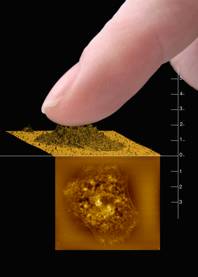
My current project Midas, uses developments in nanotechnology to explore the space between humans and objects at a nano level. This investigation analyses data recorded with an Atomic Force Microscope (AFM) in order to visualise the transference that occurs when humans touch a material.
The particle exchange that takes place between the skin and materials examines a scale within the human context, exploring below the cellular level. At an atomic level the body may be envisaged as having no spatial boundaries.
The emergent imaging methods of nanotechnology are generally based on an Old World order of a perspectivally constructed space. The Midas’ projects exploration of trans-interstitial spaces at an atomic level could provide a reconfiguration of our understanding of perspectival space. Nanotechnology offers us new ways of exploring spatiality, while recapitulating the pervasive presence of perspectival systems. The Midas project deconstructs, investigates and even maps the challenges of post-perspective spatialities.
Introduction
Our bodies penetrate the sofas upon which we sit, and the sofas penetrate our bodies. The motor bus rushes into the houses which it passes, and in their turn the houses throw themselves upon the motor bus and are blended with it. [3]
This quote from the Technical Manifesto of Futurist Painting, 1910, identifies the space between touch, touching and touched, a concept which is explored in the Midas project. Midas is a visual and sonic art installation that amplifies the experience of events at an atomic level by representing the particle exchanges that takes place when we touch.
The Midas project is analogous to the curse, of the fabled Midas, King of Phrygia to whom Dionysus gave the power of turning all that he touched into gold. This gift of touch soon changed from the King’s pride in his ability, to a curse, as even his food and drink transformed to gold. The King lost his ability to sustain himself emotionally and physically.

Fig 2 Composite image of skin touching the cell mimicking the tactility of (AFM’s) cantilever. Photo credit: Paul Thomas
The Midas story parallels the transmutability predicted by some nano scientists. As early as 1959, in his paper There's Plenty of Room at the Bottom, Richard Feynman made social predictions concerning the potential of nanotechnology to transmute knowledge. He stated that there ‘is enough room on the head of a pin to put all of the Encyclopedia Britannica’. [4] Eric Drexler further explored these ideas in his 1986 book Engines of Creation: The Coming Era of Nanotechnology, in which he hypothesized a ‘grey goo’ theory, suggesting that manipulating atoms could lead to a chain reaction where self-replicating nanobots became destructive. [5] The action of the nanobots would call to mind the touch of the mythical King Midas. Bill Joy discussed these concepts of transference and transformation in an article for Wired magazine: “It is most of all the power of destructive self-replication in Genetics, Nanotechnolgy and Robotics (GNR) that should give us pause”. [6]
1. My creative practice investigates the effects of perspective as a pervasive paradigm for imaging the world by examining (through digital video, photographically and sonically) interictal spaces in the environment. http://www.visiblespace.com
2. The paradigmatic mathematical theory of single-point perspective is fundamental to the imagining and construction of space in modern times. As Erwin Panofsky pointed out
In a sense, perspective transforms psychophysiological space into mathematical space. It negates the differences between front and back, between right and left, between bodies and intervening space (‘empty’ space), so that the sum of all the parts of space and all its contents are absorbed into a single ‘quantum continuum’. Panofsky, E. (1991). Perspective as Symbolic Form. New York, NY, Zone Books. P 31
3. Boccioni, U., C. Carrà, et al. (1973). Technical Manifesto of Futurist Painting. Futurist Manifestos. U. Apollonio. London, Thames and Hudson Ltd. P 28
4. Feynman, R. P. (2006). "There's Plenty of Room at the Bottom." Retrieved 11/01/07, 2007, from http://www.zyvex.com/nanotech/feynman.html.
5. Drexler, K. E. (2007). "Engines of Creation The Coming Era of Nanotechnology." Retrieved 11/01/07, 2007, from http://www.e-drexler.com/d/06/00/EOC/EOC_Table_of_Contents.html.
6. Joy, B. (2007). "Why the future doesn't need us." Retrieved 11/01/07, 2007, from http://www.wired.com/wired/archive/8.04/joy.html.